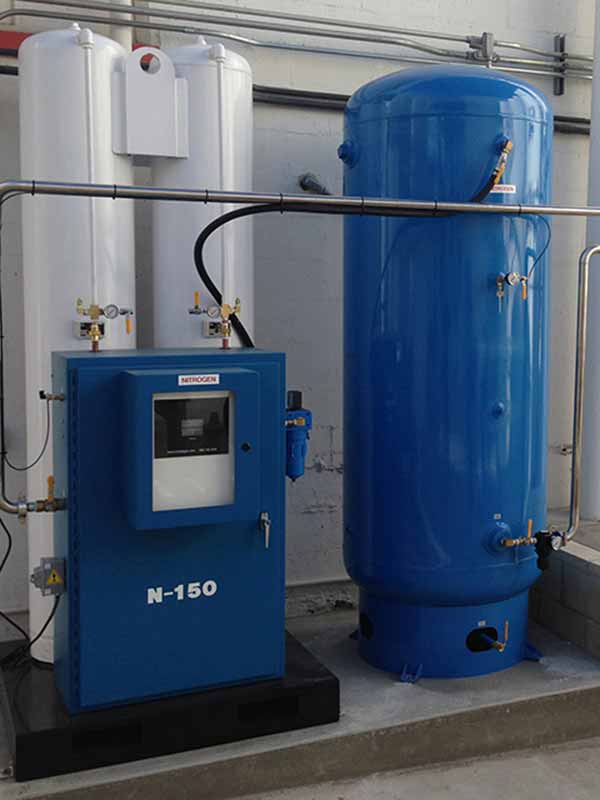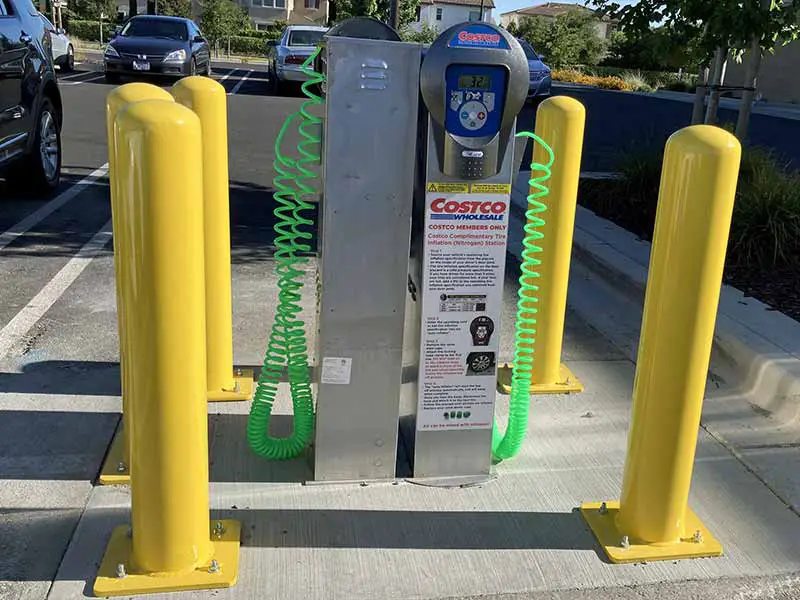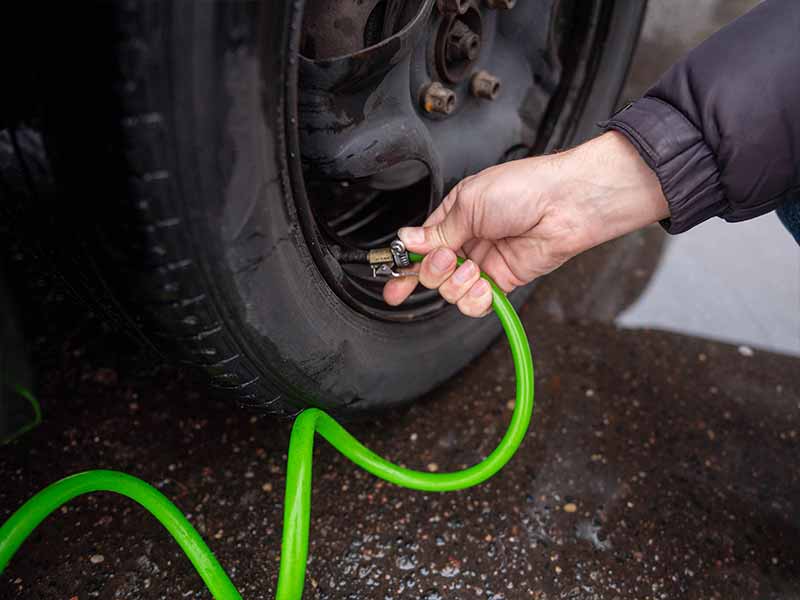Many drivers are turning to nitrogen-filled tires for their supposed benefits, but what happens when you need to add air to them? We’ll also look at the downsides and how to be prepared the next time you need to adjust the pressure in your tires.
Can You Add Air To Nitrogen-Filled Tires?
Mixing nitrogen and air is safe and occasionally necessary to ensure your tires are not underinflated when you can’t access a nitrogen fill station. However, this can reduce the benefits of having nitrogen tires.
You may need to remove the air in your tires and have them filled with nitrogen again to ensure the nitrogen purity is above 93%.
Filling tires with normal air to ensure they are at the proper tire pressure is more important than a nitrogen-filled tire’s benefits.
Proper tire pressure and maintenance should not be less important than any concerns you may have over mixing air in tires filled with nitrogen.
Let’s take a closer look.

What Happens If You Put Air In Nitrogen Tires?
If you put air in nitrogen-filled tires, it will dilute the concentration of nitrogen in the tires. Air is made up of 78% Nitrogen, 21% Oxygen, and 1% other gases, so putting air in nitrogen-filled tires, will decrease the purity of the nitrogen.
This can lead to some problems if you are intent on ensuring your nitrogen tires are filled with pure nitrogen:
- Increased tire pressure fluctuation: Nitrogen is less susceptible to temperature changes than air, so if you put air in nitrogen-filled Tires, it will increase the tire pressure fluctuation. This can lead to uneven tire wear and a decrease in fuel efficiency.
- Loss of performance benefits: Nitrogen-filled tires provide several performance benefits, such as longer tire life and improved fuel efficiency.
- Reduced cost-effectiveness: Nitrogen-filled tires are more expensive than traditional air-filled Tires, and the cost of nitrogen inflation services can add up over time.
Nitrogen purity needs to be above 93% to achieve the benefits of nitrogen in your tires. It’s not practical to get your tires 100% filled with nitrogen. Adding regular air to your tires inflated with nitrogen should be fine if the difference is very small.
A big difference in pressure loss that requires more regular air means you’ll need to deflate your tires and have them filled with nitrogen again if you want to ensure you’re getting all the benefits of nitrogen tires.
Quality portable air pumps like the one above are much more accurate and reliable.
Where To Get Nitrogen For Tires
You can find nitrogen inflation services at various locations, including tire shops, automotive service centers, and gas stations.
Tire Shops
Many major tire brands, such as Goodyear and Michelin, offer nitrogen inflation services at their authorized dealers. These dealerships typically use specialized equipment to inflate tires with nitrogen and can provide other tire-related services, such as rotation and alignment.
Service Centers
Some Jiffy Lube and Midas locations also offer nitrogen inflation services. They typically use specialized equipment to inflate tires with nitrogen, and their technicians are trained to handle the process. They also provide various automotive services, including traditional tire inflation, oil changes, and brake repair.
Gas Stations
Some gas stations may also have nitrogen inflators, but this is much rarer. Before making the trip, call around to find out if your local gas stations can add nitrogen to tires.

Free Nitrogen Tire Fill
Pure nitrogen for maintaining proper tire pressure levels isn’t usually found for free. But there are promotions and perks from some tire shops or other places that provide passenger cars and trucks services.
For instance, members of Costco can access nitrogen refill stations for free as long as they maintain their membership. When purchasing other services, keep an eye out for other places that offer free nitrogen for your tires.
How To Fill Tires With Nitrogen At Home
Nitrogen inflation kits for use at home are becoming increasingly popular as a way for people to inflate their tires with nitrogen without going to a service center. These kits typically include a nitrogen generator and an inflation hose. The nitrogen generator separates nitrogen from the air, and the inflation hose fills the tires with nitrogen.

Nitrogen Cylinder Regulator For Home Inflation
Using a nitrogen inflation kit at home is relatively simple. The process usually involves connecting a regulator to a nitrogen cylinder that you can purchase at your local welding supply.
While nitrogen inflation kits are convenient and allow you to inflate your tires with nitrogen at home, they can be expensive. Also, it’s important to follow the manufacturer’s instructions carefully and use the kit in a well-ventilated area.
How To Properly Maintain Nitrogen Tires
Maintaining nitrogen-filled tires is similar to maintaining traditional air-filled tires. However, there are a few key things to remember to ensure that your nitrogen-filled tires last as long as possible and perform at their best.

- The first step in maintaining nitrogen-filled tires is regularly checking the air pressure. Nitrogen-filled tires lose pressure at a slower rate than traditional air-filled Tires, but it’s still important to check the pressure at least once a month or more frequently if you do a lot of driving. It’s important to check the pressure when the tires are cold and inflate them to the recommended pressure indicated in the vehicle’s owner’s manual.
- The second step is to rotate your tires every 6,000 to 8,000 miles. This will help ensure that your tires wear evenly and last as long as possible. It’s also important to have your tires balanced and aligned every time you rotate them.
- The third step is to have your tires inspected by a professional at least once a year. A professional can check for any signs of wear, damage, or other issues that may not be visible to the naked eye. They can also advise you when it’s time to replace your tires.
Finally, driving carefully and avoiding overloading your vehicle, making sudden stops, sharp turns, or high-speed driving is important. These actions can cause your tires to wear out faster and affect the pressure of nitrogen-filled tires.
How To Check Nitrogen Tire Pressure
Checking the pressure of nitrogen-filled tires is similar to traditional air-filled tires. Here are the steps to check nitrogen tire pressure:

Tire Pressure Gauge w/Tread Depth Gauge
- Locate the recommended tire pressure for your vehicle: This information can be found in the vehicle’s owner’s manual or on the tire information sticker inside the driver’s door jamb.
- Purchase a quality tire pressure gauge: There are several tire pressure gauges available, such as stick gauges, dial gauges, and digital gauges.
- Remove the valve cap from the tire valve stem: The valve stem is located inside the tire and is where the air is added or released.
- Press the tire pressure gauge onto the valve stem and hold it firmly in place: Make sure not to press too hard, as this can give an inaccurate reading.
- Read the pressure on the gauge: Compare it to the recommended pressure for your vehicle. If the pressure is too low, use a nitrogen inflation hose or a nitrogen compressor to add more pressure to the tire. If the pressure is too high, use the valve stem to release some air until it reaches the recommended pressure.
- Repeat the process for each tire: It’s important to check the pressure in all four tires and the spare tire if your vehicle has one.
- Reinstall the valve caps: Valve caps keep dirt and moisture out of the valve stem and core.
It’s important to note that it’s recommended to check the tire pressure when the tires are cold, as the pressure in the tires can increase as the tires heat up while driving. Also, it’s important to check the pressure at least once a month or more frequently if you drive a lot.
Resources
Below are some links you may find helpful when learning about tires
Final Thoughts
It’s far more important to ensure your properly inflated tires than waiting to find a place you can put pure nitrogen in them. You may lose the benefits of nitrogen tires in the short term, but you can always have them filled with nitrogen again later.
Nitrogen tires have benefits over tires inflated with compressed air, but your tires can become unevenly work quickly and lose grip when under-inflated.
Good luck and happy motoring.





